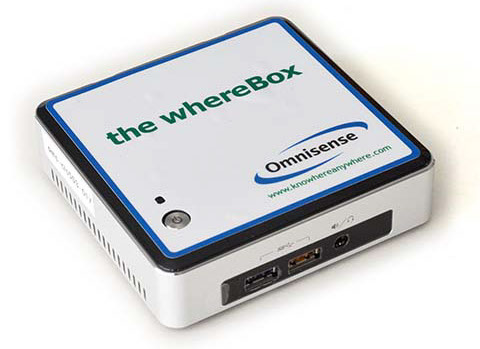
Quick Start Guide
Introduction
The whereBox is at the heart of the localisation system. It is responsible for collecting raw data measurements from devices (tags, beacons, anchors) and converting them into high level localisation information that is presented to applications using an industry standard API.
Component Parts
- Intel NUC, preconfigured with the Omnisense omniWhere application software;
- Power adapter with assorted plugs;
- VESA mounting hardware;
- microHDMI to HDMI display cable;
- USB keyboard (NOT included);
- USB mouse (NOT included);
- HDMI display (NOT included);
- Ethernet patch cable (NOT included);
- geolocation nodes (NOT included).
The whereBox is designed to work with a range of different geolocation hardware. At present two different systems are supported: Omnisense S500, and Nanotron swarm bee.

Connecting up the System
Typical Usage
- Select and fit the appropriate plug adapter to the mains power block;
- Plug the power adapter into a wall socket and into the back of the whereBox;
- Plug in a USB keyboard and USB mouse;
- Connect an HDMI display to the whereBox;
- Connect the whereBox to the LAN using an Ethernet patch cable if using Ethernet
- Plug the gateway device into a USB port on the whereBox, or into the Ethernet LAN depending on the type of gateway being used
Starting the System
Press the button on the top of the whereBox to power it on. The omniWhere application will launch automatically and display the default opening screen.
Use Alt-Tab to switch between the omniWhere application and a web browser containing status and configuration pages from which full documentation for the product can be accessed
All user manuals and documentation are available within the web pages on the whereBox. They are also available on-line. To call up context sensitive help from within the omniWhere application click the help icon in the icon bar at the top of the screen, or right click in the area of interest and select Help from the pop-up context menu.
To shut the whereBox down press the “shutdown” button on the main status web page before turning off the power.
A typical configuration has four or more geolocation devices installed at known positions. These are called fixed devices, or anchors or beacons. Their positions are entered into the configuration pages in the omniWhere application and they are used as a reference for computed positions.
One or more additional geolocation devices are used as mobiles and their positions are tracked in real-time, displayed on the diagnostic screen displays that are part of the omniWhere application and are made available to external applications connecting to the application API. These devices are typically referred to as tags or mobiles.
The whereBox captures raw data, computes positions, saves data logs and makes the output location measurements available to external applications. It also provides tools to assist with setting up, configuring and running the system and tools for analysis of the data and problem diagnosis.
Supported Hardware
The whereBox supports two different kinds of physical geolocation systems:
- Omnisense S500
- Nanotron swarm bee
Additional systems and devices will be added to the compatibility list in due course, including GPS and beacon (BLE) technologies.
knowhere anywhere
3rd Floor, St Andrew's House, 59 St Andrew's Street, Cambridge, CB2 3BZ, UK
tel: +44 1223 651390, email: info@omnisense.co.uk
Copyright © 2016, Omnisense Ltd